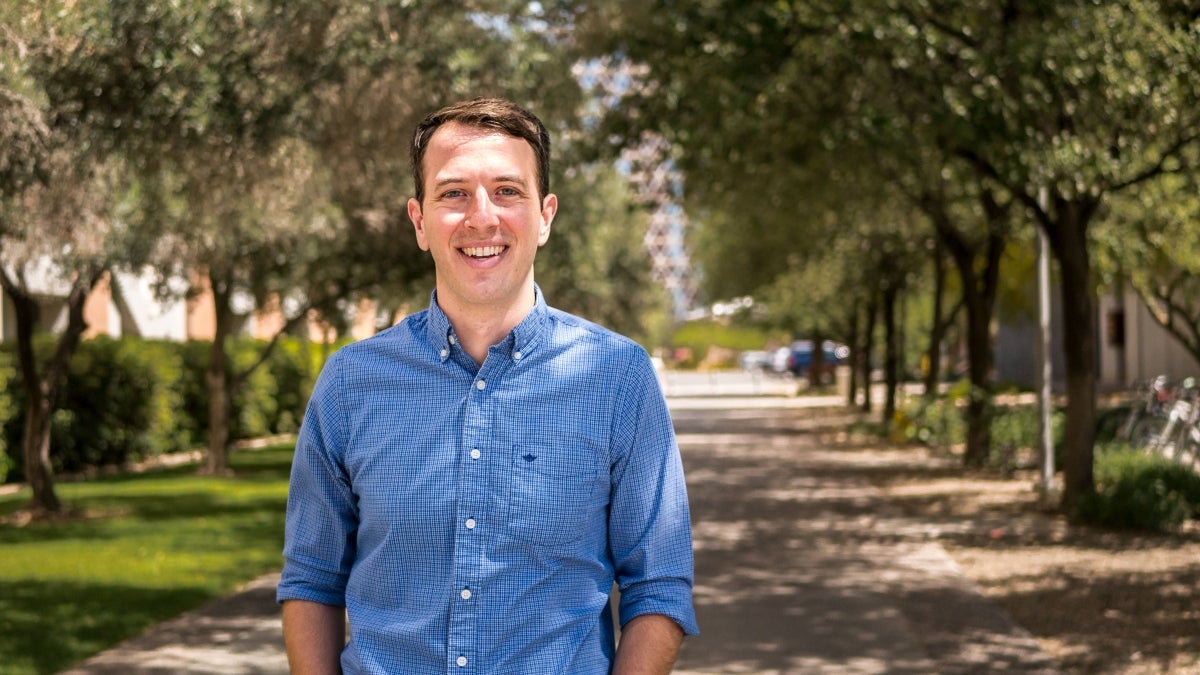ASU psychology graduate student wins American Psychological Association dissertation award

Michael Sladek, a psychology graduate student, won a doctoral dissertation research award from the American Psychological Association for his proposal to study Latino students as they transition to college life at ASU. Photo by Robert Ewing
Starting college is exciting, but it also can be stressful, especially for minority students. Researchers in the Arizona State University Department of Psychology are studying ways that Latinos adapt to the stressors of higher education and what promotes their academic success.
Michael Sladek, a psychology graduate student, won a doctoral dissertation research award from the American Psychological Association (APA) for his proposal to study Latino students as they transition to college life at ASU.
“I am interested in how cultural influences affect how people deal with stress,” Sladek said.
The APA funds allowed Sladek to study how Latino students in their first semester at ASU handle stress. Sladek’s experiment is part of a larger study run by his advisor, Leah Doane, associate professor of psychology.
“We are interested in how culture affects development,” Doane said. “We are looking at how culture impacts the effects that stress from adjusting to a new environment can have on health, mental health and academic success.”
The Doane lab “Transiciones” study tracks how ASU Latino students adjust to college by following them starting in their senior year of high school through their third year in college. It is funded by the William T. Grant Foundation and receives logistical support from ASU admissions and Educational Outreach and Student Services.
Last year, Doane’s lab began tracking over 200 Latino students who had committed to attend ASU. The first part of the Transiciones study was an eight-day period when the students were still living at home and attending high school. The researchers asked the students to complete smart-phone based daily surveys, monitored the quality of their sleep and collected information about their stress levels and general health. The lab repeated the same eight-day protocol one year later, when the Latino students were in their second semester at ASU.
Sladek’s experiment included a smaller group of Transiciones students who first watched a video and then spent a few minutes talking about themselves before a panel of two judges. The judges were trained researchers and the public speaking situation was designed to create stress. To measure stress, the researchers asked the students questions about their mood and collected saliva samples before and after the experiment. The saliva samples were used to measure changes in cortisol, a hormone produced by the body during stress.
Sladek wanted to know whether the video watched by the students affected their stress levels.
“One video was made by ASU, and it focuses on how culture, diversity and inclusion are all really important at ASU,” Sladek said. “The other video was a generic tour of campus.”
Sladek and Doane thought that the students who watched the video about how ASU values diversity and inclusion would feel less stress during the experiment. Sladek thought that reminding students of their background would help them feel more connected to their culture while they navigated the university environment.
“We wanted to see if the students who watched the ASU inclusion video felt more comfortable and could draw from their own background when they stood up in front of the judges,” Sladek said.
Sladek compared the answers to the questions about mood and the amounts of cortisol measured from the students who watched the supportive inclusion video to the students who watched the campus tour. He found that the students who watched the supportive inclusion video did not react as dramatically to the stress task, an effect that was strongest for students with a greater connection to their cultural heritage, like valuing family and respecting authority figures.
“We’re excited by these findings because they supported our hypothesis and show that the initiatives and messages ASU is already giving to incoming students can make a difference,” Sladek said. “The findings from this study highlight the cultural diversity among Latino students, which has important implications for students as they start college classes (and) interact with professors and other students.”
To apply for the APA dissertation award, Sladek wrote a summary of the experiments he wanted to include in his doctoral dissertation. His application was one of two selected to be sent to the APA by Laurie Chassin, Regents’ Professor and director of graduate training in the psychology department.
Sladek and fellow psychology graduate student Carter Daniels both were among the approximately 40 students nationwide selected by the APA for dissertation awards.
“The APA dissertation award is an honor for our ambitious and entrepreneurial students,” Chassin said. “And it is a credit to the training they receive in the Department of Psychology.”
After completing his doctorate at ASU, Sladek will move to Harvard University to work with former ASU professor Adriana Umaña-Taylor.
More Science and technology

ASU and Deca Technologies selected to lead $100M SHIELD USA project to strengthen U.S. semiconductor packaging capabilities
The National Institute of Standards and Technology — part of the U.S. Department of Commerce — announced today that it plans to…

From food crops to cancer clinics: Lessons in extermination resistance
Just as crop-devouring insects evolve to resist pesticides, cancer cells can increase their lethality by developing resistance to…

ASU professor wins NIH Director’s New Innovator Award for research linking gene function to brain structure
Life experiences alter us in many ways, including how we act and our mental and physical health. What we go through can even…